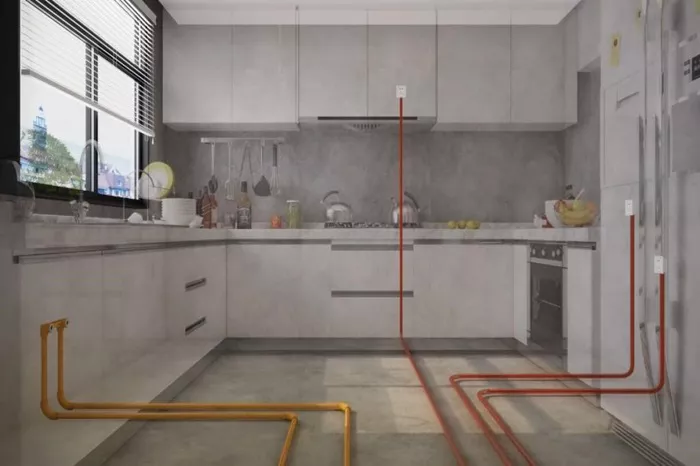Running a gas line in your house is a major project that requires careful planning, the right tools, and professional help. Whether you’re adding a gas stove, water heater, or outdoor grill, understanding the cost of installation is important. In this article, we’ll break down the expenses, types of gas lines, safety rules, and other key factors.
Cost Overview
The cost to run a gas line in a house can range from $120 to $2,000 or more. The price depends on several things like how far the line runs, what kind of pipe is used, and how easy it is to access the installation site.
Average Costs
Minimum Cost: $120 (short extension with easy access)
Typical Range: $300 – $800 (most common household jobs)
High-End Cost: $2,000+ (long lines, complex installation, or new construction)
Breakdown of Costs
Labor: $45 – $150 per hour. Most jobs take 2 to 6 hours.
Materials: $1 – $10 per foot for the pipe (black iron, CSST, or copper)
Permits: $50 – $200 depending on your city or county
Equipment Rental: $50 – $150 if trenching or cutting tools are needed
Hiring a licensed plumber or gas technician usually includes labor and tools in the price. Always ask for a detailed estimate.
Factors Affecting Cost
Gas line installation costs are affected by a few important things:
Length and Diameter of the Gas Line
Longer lines cost more due to the extra materials and labor. Also, bigger appliances may need wider pipes. Wider pipes cost more.
Type of Installation
New Line: Most expensive. It may need permits, trenching, and major planning.
Extension: Cheaper. Adds a branch to an existing gas line.
Replacement: Cost varies depending on access and condition of the old pipe.
Accessibility and Complexity
If your gas line needs to run under concrete, behind walls, or through tight spaces, the job gets harder. More labor and special tools raise the cost.
Crawl spaces or basements: Easier and cheaper.
Concrete slab homes: More expensive because of the cutting required.
Types of Gas Lines
Natural Gas vs. Propane
Both natural gas and propane need gas lines, but they’re used in different areas and have different supply setups.
Natural Gas: Common in cities. It comes from a utility company. Installation costs may be lower if the home is already connected to the gas grid.
Propane: Used in rural areas. Requires a tank and sometimes a regulator. The lines may need to be designed differently.
Cost Differences
Natural gas lines usually cost less to install if the home is already connected. Propane lines may cost more due to extra components like regulators and tanks.
Permits and Regulations
Permits
You’ll likely need a permit to install or modify gas lines. Fees vary by city but usually range from $50 to $200.
Getting a permit ensures the work is inspected and meets safety standards. Skipping this step can lead to fines or insurance problems.
Local Codes
Every state and city has its own building codes. Your installer should know these and follow them. Codes cover things like:
Depth of buried lines
Type of piping allowed
Pressure testing requirements
Safety Considerations
Gas is dangerous if not handled properly. Leaks can cause fires, explosions, or health risks.
Hire Licensed Professionals
Never DIY a gas line unless you’re licensed. Even small mistakes can lead to serious hazards.
Licensed plumbers or gas fitters know how to:
Seal joints correctly
Pressure test lines
Handle permits and inspections
Safe Installation Tips
Always test for leaks before turning on the gas
Use approved materials and tools
Keep gas lines away from electrical wires and water lines
After installation, make sure your home has a working carbon monoxide detector.
Additional Costs
Some gas line projects come with extra expenses you should plan for:
Trenching
If the gas line needs to go underground, trenching may be required. Costs can range from $10 to $25 per foot.
Connecting to Main Line
If you’re adding a new natural gas connection, the utility company may charge a hookup fee. This can range from $300 to $1,000+.
Meter Installation
New connections may require a new gas meter. Some utility companies include this in the hookup cost, but others charge $100 to $400.
Removal of Old Lines
Taking out unused or damaged gas lines may cost extra, especially if the lines are hard to reach.
Appliance Hookup
Connecting your gas line to the appliance and testing it usually costs an extra $100 to $300.
Conclusion
Running a gas line in your house isn’t a simple DIY project. It requires knowledge of tools, materials, safety rules, and permits. The total cost ranges from $120 to $2,000 or more, depending on the job. Always get a licensed professional to do the work, and make sure everything meets local codes.
With proper planning and a clear understanding of the costs, you can safely add gas appliances to your home. Be sure to compare quotes, check licenses, and ask about permits before the work begins. That way, you’ll avoid surprises and make sure the job is done right.
Related topics:

